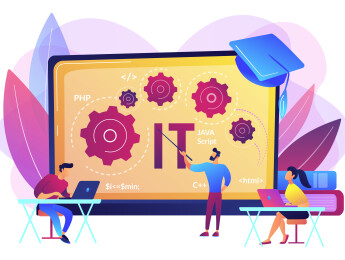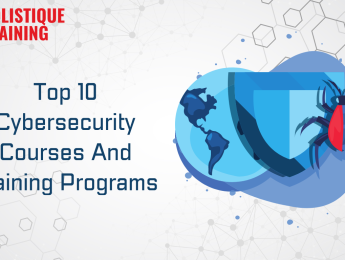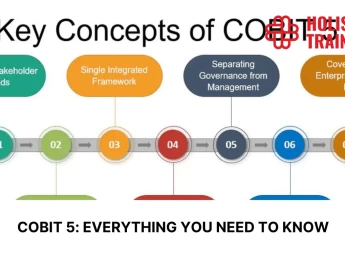- Table of Contents
- Introduction
- What Is a Management Committee?
- Why Is It Important to Have a Management Committee?
- Collective Wisdom and Diverse Perspectives
- Strategic Decision-Making
- Governance and Accountability
- Stakeholder Representation
- Long-Term Vision and Stability
- Mitigation of Unilateral Decision-Making
- Adapting to Change
- Collective Responsibilities of a Management Committee
- Responsibilities of Each Role in a Management Committee
- Chair
- Vice Chair
- Secretary
- Treasurer
- Committee Members
- Ad Hoc Roles
- How Can You Become a Member of a Management Committee?
- 1. Expressing Interest and Involvement
- 2. Showcase Commitment
- 3. Highlight Relevant Skills and Expertise
- 4. Networking and Relationship Building
- 5. Seek Mentorship
- 6. Volunteer for Relevant Initiatives
- 7. Attend Training and Development Opportunities
- 8. Express Your Intent
- 9. Participate in the Nomination Process
- 10. Be Patient and Persistent
- Benefits of Having a Training and Development Strategy for Your Management Committee
- Enhanced Decision-Making and Strategic Thinking
- Improved Communication and Collaboration
- Financial Acumen and Fiscal Responsibility
- Leadership Development
- Adaptability to Change
- Ethical Governance and Compliance
- Succession Planning
- Innovation and Creativity
- Improved Organisational Performance
- Commitment to Continuous Improvement
- Statistics on Board Development Training
- Step-by-step Process of a Training and Development Strategy
- 1. Needs Assessment
- 2. Goal Definition
- 3. Objective Setting
- 4. Training Methods Selection
- 5. Resource Identification
- 6. Curriculum Development
- 7. Implementation Planning
- 8. Engagement and Participation
- 9. Evaluation Metrics
- 10. Continuous Improvement
- 11. Documentation and Reporting
- 12. Celebration of Achievements
- Conclusion
Introduction
Embarking on the dynamic terrain of organisational leadership, we journey into the realm of the Management Committee—a nucleus where strategic decisions resonate and the pulse of effective governance is felt. Beyond a mere administrative body, the Management Committee embodies the architects of an organisation's destiny. Join us in this blog post as we navigate the intricate architecture of leadership roles and responsibilities and their profound impact on the ever-evolving tapestry of success.
What Is a Management Committee?
A Management Committee, often referred to as the Board of Directors, is an organisation's pulsating nerve centre. It comprises individuals with diverse skills, experiences, and perspectives and functions as the guiding force behind strategic decisions. The lineup typically includes a Chair, Vice Chair, Secretary, Treasurer, and additional members, each bringing a unique set of skills to the table.
Why Is It Important to Have a Management Committee?
In the world of organisational governance, the Management Committee emerges as the linchpin, playing a role far beyond mere formalities. Its existence is not a bureaucratic checkbox but a strategic imperative that resonates throughout the organisation. Here’s why:
Collective Wisdom and Diverse Perspectives
An organisation, much like a thriving ecosystem, thrives on diversity. The Management Committee is a microcosm of this diversity, comprising individuals with varied backgrounds, experiences, and skill sets. This amalgamation of perspectives ensures a comprehensive view of challenges and opportunities. The committee becomes a melting pot of ideas, enriching decision-making processes with insights that might not emerge in a more homogenous setting.
Strategic Decision-Making
In the fast-paced and ever-evolving business landscape, strategic decision-making is paramount. The Management Committee, with its collective intelligence, becomes the fulcrum upon which these decisions pivot. By leveraging the expertise of its members, the committee can navigate uncertainties, assess risks, and chart a course that aligns with the organisation's overarching goals. This strategic prowess isn't just a luxury; it's a necessity for sustainability and growth.
Governance and Accountability
An effective Management Committee establishes a robust governance framework. It acts as a check and balance mechanism, ensuring that decisions align with the organisation's mission, vision, and values. This fosters accountability and safeguards against the risks associated with unchecked authority. The committee becomes the guardian of the organisation's integrity, setting the tone for ethical conduct and responsible management.
Stakeholder Representation
Organisations are multifaceted entities with many stakeholders - employees, customers, investors, and the community. The Management Committee, as the apex decision-making body, represents the interests of these diverse stakeholders. Doing so ensures that decisions are aligned with the organisation's strategic objectives and considerate of the broader impact on the community and society. And it seems like many companies trust their boards to do so since, according to a PwC survey, most executives, accounting for 68%, express confidence in their boards' ability to engage effectively with shareholders.
Long-Term Vision and Stability
A Management Committee is the custodian of the organisation's long-term vision. While day-to-day operations are crucial, the committee's focus extends beyond the immediate horizon. It cultivates a culture of foresight, guiding the organisation toward sustained growth and adaptability. In times of turbulence, the committee becomes the anchor, providing stability and strategic direction that transcends transient challenges.
Mitigation of Unilateral Decision-Making
Without a structured decision-making body, the risk of unilateral decision-making looms large. A Management Committee acts as a counterforce, ensuring that decisions result from collective deliberation rather than the whims of a single individual. This collaborative approach enhances the quality of decisions and fosters a sense of ownership among committee members.
Adapting to Change
The business landscape is dynamic, marked by constant change and evolving trends. A Management Committee is, by its very nature, equipped to navigate these changes. Its members' diverse skills and experiences enable the organisation to adapt to emerging challenges and capitalise on new opportunities. It becomes a beacon of agility in a sea of uncertainty. In essence, the importance of having a Management Committee transcends the confines of governance structures. The beating heart infuses vitality into the organisation, fostering resilience, innovation, and sustained success. As we celebrate the first year of our journey, it's a testament to the foresight that led to establishing this vital entity—a cornerstone upon which the edifice of organisational excellence is built.
Collective Responsibilities of a Management Committee
The strength of a Management Committee lies in its collective responsibilities. A unit must define and uphold the organisation's mission, vision, and values. Strategic planning, risk management, and financial oversight fall within the committee's purview, fostering an environment of stability and foresight.
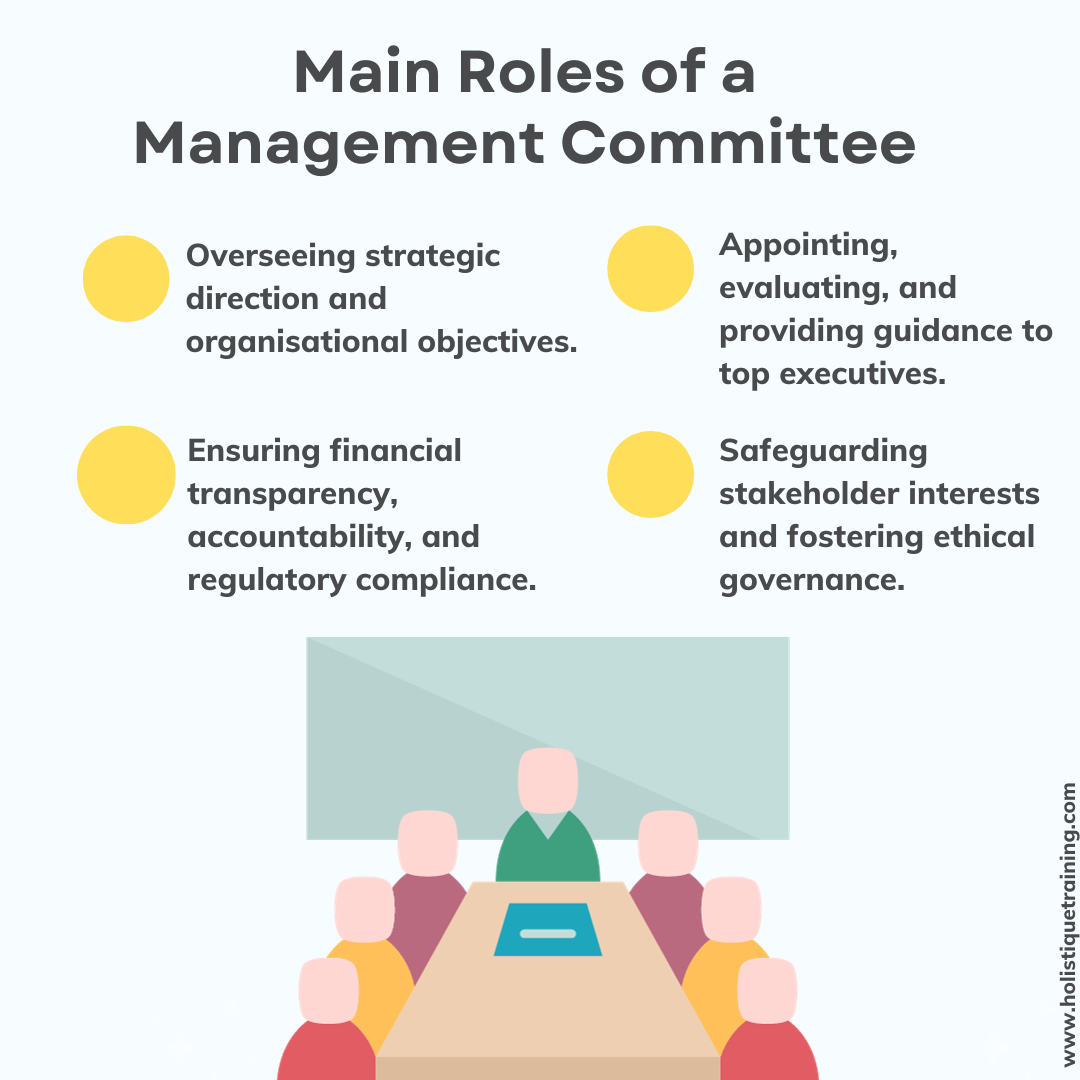
Responsibilities of Each Role in a Management Committee
Chair
At the committee's helm, the Chair is more than just a figurehead; they are the orchestrator of strategic discussions and the steward of consensus. The Chair's primary responsibility is to lead meetings, ensuring that discussions remain focused, participative, and conducive to decision-making. Beyond this, the Chair sets the tone for the committee's culture, fostering an environment of collaboration and constructive dialogue. They act as the public face of the committee, representing it to external stakeholders with charisma and authority.
Vice Chair
The Vice-Chair is not merely a deputy but a strategic partner to the Chair. In the Chair's absence, the Vice Chair steps into the leadership role, showcasing continuity and a unique perspective. Collaborating closely with the Chair, the Vice Chair often leads specific initiatives, offering a fresh lens and innovative ideas. This role demands competence and a keen understanding of the organisation's ethos, contributing to the committee's strategic vision.
Secretary
The Secretary assumes the crucial responsibility of being the committee's custodian of records and communication. The key responsibilities of this role include diligently recording minutes of meetings, maintaining official documents, and facilitating transparent communication within the committee. The Secretary ensures that the organisational memory is preserved, offering historical context for decision-making. Beyond documentation, they are pivotal in coordinating meeting logistics and ensuring that the committee functions smoothly.
Treasurer
Financial stewardship falls under the purview of the Treasurer. This role extends far beyond number crunching; it's about strategic financial planning and ensuring the organisation's fiscal health. The Treasurer tracks budgets, oversees financial reports, and provides insights into the economic implications of strategic decisions. With an analytical insight, the Treasurer is the financial compass guiding the committee through economic landscapes, ensuring the organisation's financial sustainability.
Committee Members
While the leadership roles carry distinct responsibilities, every committee member contributes to the group's collective wisdom. Committee members actively engage in discussions, leveraging their individual expertise to shape decisions. They serve as liaisons to different facets of the organisation, representing diverse perspectives. They are responsible for staying informed, bringing forth concerns, and actively participating in the committee's initiatives. The Management Committee's strength lies in its members' diversity and commitment to the organisation's mission.
Ad Hoc Roles
Depending on the organisation's needs, additional roles may be assigned ad hoc. These roles could include task force leaders, committee liaisons, or project managers. While not part of the core structure, these roles are pivotal in addressing specific challenges or opportunities, showcasing the committee's adaptability.
In essence, the responsibilities of each role in a Management Committee form a symbiotic relationship. The Chair provides leadership, the Vice Chair offers strategic support, the Secretary ensures transparency, the Treasurer navigates financial landscapes, and committee members bring diverse perspectives to the table. The synergy of these roles empowers the committee to navigate the complexities of governance, steering the organisation toward excellence. Celebrating the first year of our journey is a testament to the dedication and collaborative spirit of each role within our Management Committee.
How Can You Become a Member of a Management Committee?
Becoming a member of a Management Committee is not a mere appointment; it's a journey paved with dedication, involvement, and a demonstrated commitment to the organisation's mission. Here are the steps you can take to embark on this transformative path:
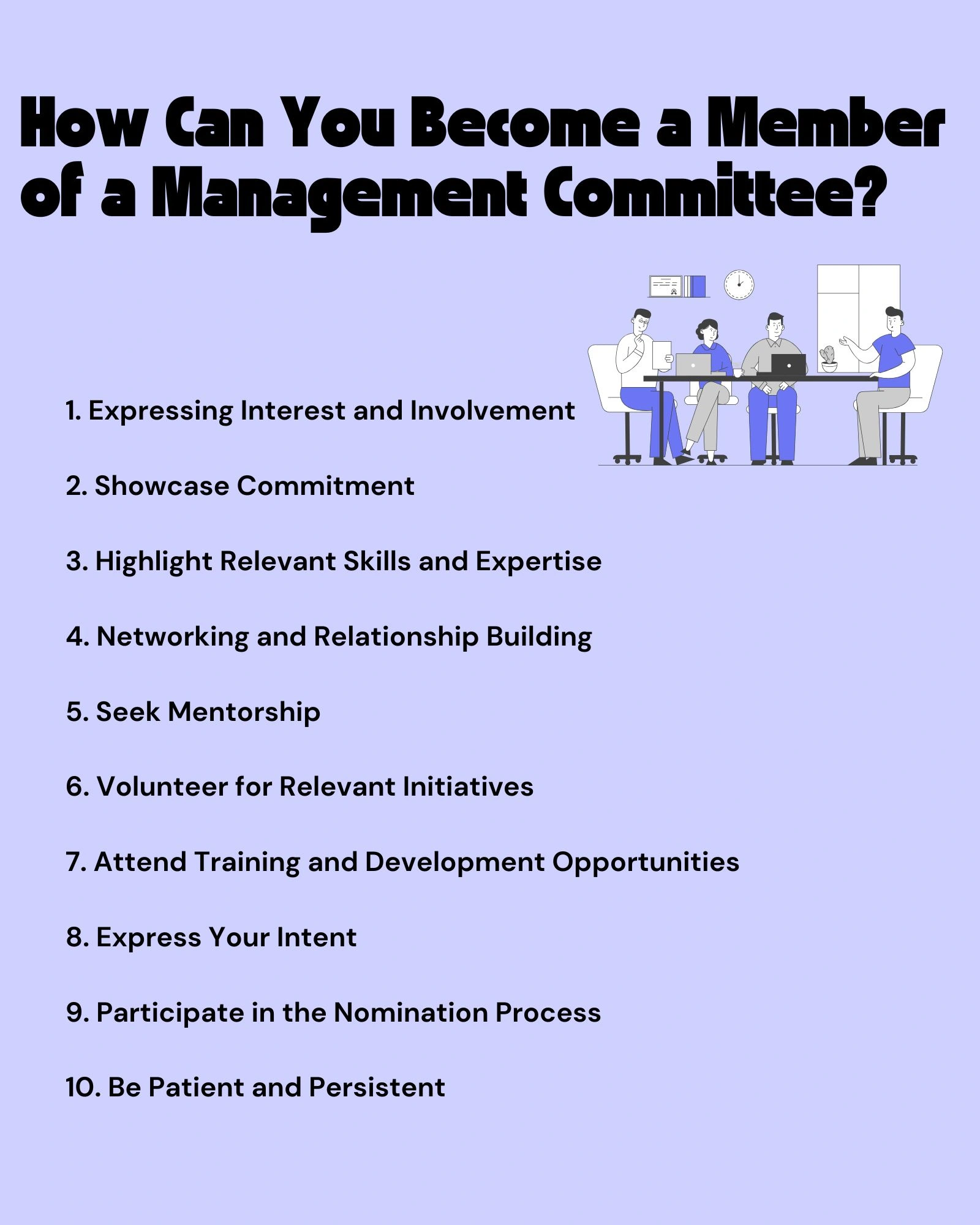
1. Expressing Interest and Involvement
The first step toward joining a Management Committee is expressing a genuine interest in the organisation's affairs. Actively participate in its activities, attend meetings, and engage with fellow members. Demonstrating your passion for the organisation's mission sets the stage for your potential role in shaping its strategic direction.
2. Showcase Commitment
Commitment is the cornerstone of effective leadership. Showcase your commitment by consistently delivering excellence in your current organisational role. Whether you are an employee, volunteer, or stakeholder, a track record of reliability and dedication is a powerful testament to your potential as a Management Committee member.
3. Highlight Relevant Skills and Expertise
Management Committees thrive on diversity of skills and perspectives. Assess your strengths and highlight how your skills align with the committee's needs. Whether it's financial acumen, strategic thinking, or leadership capabilities, articulate how your unique expertise can contribute to the committee's goals.
4. Networking and Relationship Building
Building relationships within the organisation is key to gaining visibility and support. Network with current committee members, organisational leaders, and stakeholders. Attend events, workshops, and functions to connect with individuals who can advocate for your potential role in the committee.
5. Seek Mentorship
Mentorship can be a powerful catalyst for growth. Identify individuals within the organisation with experience on the Management Committee or leadership roles. Seek their guidance, learn from their experiences, and let their mentorship guide your journey toward committee membership.
6. Volunteer for Relevant Initiatives
Demonstrate your commitment and capability by actively volunteering for initiatives aligned with the organisation's strategic goals. A hands-on approach showcases your dedication and provides tangible evidence of your ability to contribute effectively.
7. Attend Training and Development Opportunities
Many organisations value continuous learning and development. Attend workshops, seminars, and training sessions relevant to governance, leadership, and strategic planning. Not only does this enhance your skill set, but it also signals to the organisation that you are invested in personal and professional growth.
8. Express Your Intent
Once you have actively participated, showcased your commitment, and developed relevant skills, express your intent to join the Management Committee. This can be done through a formal letter of interest or by engaging in conversations with key decision-makers within the organisation. Clearly communicate how your involvement will add value to the committee and contribute to the organisation's success.
9. Participate in the Nomination Process
Many Management Committees have a formal nomination and election process. Familiarise yourself with these procedures and actively participate. Whether it involves submitting a nomination or presenting your candidacy, engage with the process transparently and ethically.
10. Be Patient and Persistent
Becoming a member of a Management Committee is often not an instantaneous process. Be patient and persistent in your pursuit. Continue demonstrating your value, engaging with the organisation, and letting your commitment shine through. Opportunities for committee membership may arise over time. In summary, the path to joining a Management Committee is a deliberate and strategic journey. You position yourself as a valuable asset by expressing interest, showcasing commitment, building relationships, and actively participating in the organisation's initiatives. Remember, it's not just about the title; it's about the impact you can make in steering the organisation toward excellence through effective governance. As you embark on this transformative journey, celebrate the opportunity to contribute to the strategic leadership that propels the organisation forward.
Benefits of Having a Training and Development Strategy for Your Management Committee
In the dynamic world of organisational governance, a forward-thinking approach involves recognising that leadership is not static; it's an evolving journey. A well-crafted Training and Development strategy for your Management Committee is not just an investment; it's a catalyst for organisational growth, adaptability, and sustained success. In fact, statistics show that organisations that extend leadership training across all tiers were 4.2 times more likely to surpass those limiting training to managerial levels. That being said, let's explore the myriad benefits that emanate from a robust commitment to training and developing your leadership core.
Enhanced Decision-Making and Strategic Thinking
Training and development initiatives equip committee members with the skills and knowledge needed for informed decision-making. Workshops and seminars on strategic thinking, risk assessment, and trend analysis foster a holistic approach to governance. As committee members expand their strategic thinking capabilities, the organisation benefits from well-informed decisions that consider long-term implications.
Improved Communication and Collaboration
Effective leadership hinges on communication and collaboration. Training programs focused on interpersonal skills, conflict resolution, and effective communication foster a culture of openness within the committee. Enhanced communication channels lead to more productive discussions, better collaboration, and a cohesive decision-making process.
Financial Acumen and Fiscal Responsibility
Training in financial management, budgeting, and fiscal responsibility would greatly benefit the treasurer and other financial roles within the committee. A deep understanding of financial intricacies would ensure that the committee can navigate economic challenges with prudence, safeguarding the organisation's financial health.
Leadership Development
Leadership isn't a static trait; it's a skill that can be honed and developed. Training programs focused on leadership development empower committee members to confidently lead, inspire their peers, and navigate complex leadership challenges. This not only benefits the committee but cascades down to influence the organisational culture.
Adaptability to Change
The business landscape is marked by constant change, and adaptability is a key determinant of organisational success. Training and development initiatives that address change management, innovation, and agility prepare the Management Committee to navigate uncertainties with poise. This adaptability ensures that the organisation stays ahead of the curve.
Ethical Governance and Compliance
Committee members are responsible for upholding ethical standards and ensuring compliance with regulations. Training programs focused on ethical decision-making, legal compliance, and corporate governance instil a strong ethical foundation. This not only safeguards the organisation's reputation but also ensures that decisions align with the highest standards of integrity.
Succession Planning
A strategic Training and Development strategy includes grooming future leaders within the committee. The organisation ensures a seamless leadership transition by identifying and nurturing emerging talents. Succession planning mitigates the risks associated with leadership gaps and fosters continuity in governance.
Innovation and Creativity
Leadership is not just about maintaining the status quo; it's about fostering innovation and creativity. Training programs that stimulate creative thinking, problem-solving, and innovation empower the committee to explore new avenues and strategies, contributing to the organisation's growth and competitiveness.
Improved Organisational Performance
The collective impact of a well-trained Management Committee is felt throughout the organisation. Informed decisions, effective communication, and strategic leadership translate into improved organisational performance. The committee becomes a catalyst for excellence, setting operational efficiency and effectiveness standards.
Commitment to Continuous Improvement
A commitment to training and development signifies a commitment to continuous improvement. The Management Committee becomes a model for a learning organisation, where growth is not a destination but a journey. This mindset permeates throughout the organisation, fostering a culture of continuous improvement and adaptability.
A Training and Development strategy for your Management Committee is not just a box to be checked; it's a dynamic force that propels the organisation forward. It acknowledges that leadership is a journey of growth, and investing in the development of committee members pays dividends in organisational resilience, innovation, and sustained success. As we celebrate the first year of our journey, let it be a testament to the commitment to continuous improvement and the unwavering pursuit of excellence in governance.
Statistics on Board Development Training
The extensive March 2018 McKinsey Global Survey, which surveyed more than 1,100 board directors, revealed a concerning trend in director training. Specifically, fewer than a quarter of respondents indicated that new directors received adequate induction training to fulfil their roles effectively. Moreover, a mere 20% of the surveyed directors reported ongoing opportunities for board education, pointing to a significant gap in continuous learning within the directorial landscape.
Step-by-step Process of a Training and Development Strategy
A comprehensive Training and Development strategy for a Management Committee requires a strategic and systematic approach. Here's a step-by-step guide to navigate the process and ensure that the strategy aligns with the organisation's goals and the evolving needs of the committee:
1. Needs Assessment
The first step is to conduct a thorough needs assessment. Engage with the committee members to identify gaps in skills, knowledge, and competencies. This can be achieved through surveys, interviews, or facilitated discussions. Understanding the committee's specific needs sets the foundation for a targeted and effective training strategy.
2. Goal Definition
Based on the needs assessment, define clear and measurable training goals. These goals should align with the committee's responsibilities, the organisation's strategic objectives, and the broader governance context. Whether it's enhancing financial acumen, fostering leadership skills, or addressing specific regulatory requirements, clearly articulate what success looks like.
3. Objective Setting
Translate the overarching goals into specific training objectives. These objectives should be actionable and time-bound. For example, if the goal is to enhance financial literacy, an objective could be for committee members to complete a financial management workshop within a specified timeframe.
4. Training Methods Selection
Diversify the training methods to cater to different learning styles and preferences. Workshops, seminars, online courses, mentorship programs, and experiential learning opportunities all contribute to a well-rounded training experience. Consider the logistics, budget, and time constraints when selecting the most appropriate methods.
5. Resource Identification
Identify the resources required for the training initiatives. This includes financial resources for external trainers or courses, materials for workshops, and technological resources for online training. Ensure the identified resources align with the budget and are readily available to support the training strategy.
6. Curriculum Development
Design a curriculum that addresses the identified training objectives. The curriculum should be structured, comprehensive, and engaging. Incorporate real-world examples and case studies relevant to the committee's responsibilities. Ensure that the content is accessible and adaptable to different learning preferences.
7. Implementation Planning
Plan the implementation of the training strategy with meticulous detail. This includes scheduling training sessions, coordinating logistics, and communicating the training calendar to committee members. Consider incorporating a mix of in-person and virtual training sessions to accommodate diverse preferences and geographical locations.
8. Engagement and Participation
Encourage active engagement and participation throughout the training process. Foster a culture where committee members feel comfortable sharing insights and asking questions. Incorporate interactive elements, group discussions, and practical exercises to enhance the learning experience.
9. Evaluation Metrics
Define clear metrics to evaluate the effectiveness of the training initiatives. This could involve pre-and post-training assessments, feedback surveys, and quantitative skill development measures. Regularly assess progress against the defined objectives to ensure the training strategy yields the intended outcomes.
Metric | Description |
Decision-Making Impact | Assess decision quality post-training. |
Communication Efficacy | Measure effectiveness in fostering open dialogue. |
Financial Literacy Growth | Evaluate improvement in financial management understanding. |
Leadership Confidence | Gauge confidence levels in leadership roles. |
Committee Collaboration | Assess the impact on collaborative efforts within the committee. |
Table 1: Metrics to evaluate the effectiveness of training initiatives
10. Continuous Improvement
Learning is an ongoing process, and a successful training and development strategy embraces the concept of continuous improvement. Solicit feedback from committee members, assess the impact of the training initiatives, and use this information to refine and enhance future training programs. Adapt the strategy based on evolving needs and emerging trends in governance and leadership.
11. Documentation and Reporting
Maintain detailed documentation of the training initiatives, including attendance records, feedback, and assessment results. Develop comprehensive reports summarising the training's impact on the committee's skills and capabilities. These reports serve as valuable insights for future training endeavours and can be shared with organisational leadership.
12. Celebration of Achievements
Celebrate the achievements and milestones reached through the training and development strategy. Acknowledge the efforts of committee members, highlight success stories, and reinforce the importance of ongoing learning within the organisation. Recognition fosters a positive culture around training and encourages a commitment to continuous improvement.
Conclusion
As we reflect on the intricate dance of roles and responsibilities within a Management Committee, it becomes evident that the strength of this entity lies not just in its composition but in its commitment to growth and adaptability. Nurturing the skills of each member, fostering collaboration, and aligning the committee with the organisation's mission are the keystones of success. In the tapestry of effective governance, the Management Committee is a testament to the collective wisdom that propels organisations forward. Cheers to a year of navigating these complexities, and here's to the continuous journey of unlocking success through strategic leadership. Finally, as we celebrate the triumphs of effective governance, consider taking the next step in your leadership journey. Elevate your skills with our ‘In-Depth Business Management Professional Training’ course, designed to empower you with the knowledge and insights needed to navigate the intricate landscape of organisational leadership. Seize the opportunity to propel your career forward and become a driving force in unlocking success through strategic leadership. Cheers to your continuous journey of growth and excellence!
















